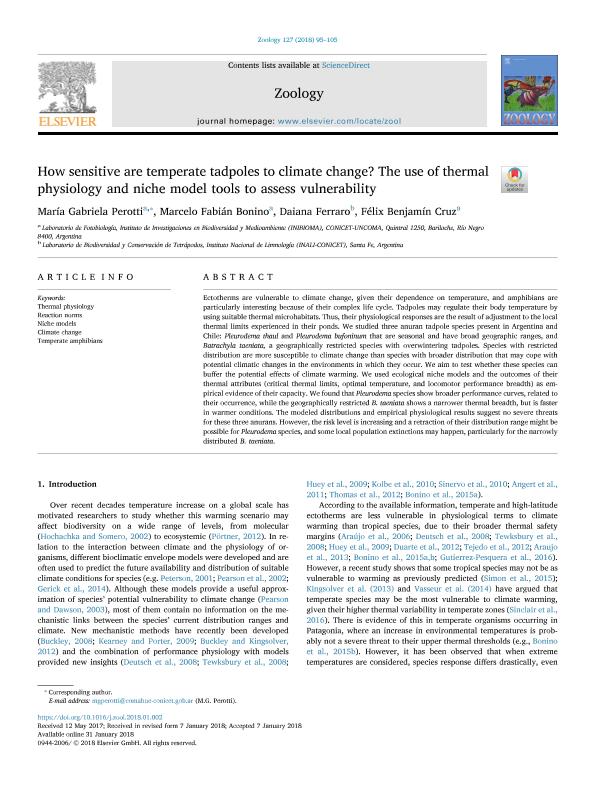Mostrar el registro sencillo del ítem
dc.contributor.author
Perotti, Maria Gabriela

dc.contributor.author
Bonino, Marcelo Fabián

dc.contributor.author
Ferraro, Daiana Paola

dc.contributor.author
Cruz, Felix Benjamin

dc.date.available
2020-01-14T21:05:58Z
dc.date.issued
2018-04
dc.identifier.citation
Perotti, Maria Gabriela; Bonino, Marcelo Fabián; Ferraro, Daiana Paola; Cruz, Felix Benjamin; How sensitive are temperate tadpoles to climate change? The use of thermal physiology and niche model tools to assess vulnerability; Elsevier Gmbh; Zoology; 127; 4-2018; 95-105
dc.identifier.issn
0944-2006
dc.identifier.uri
http://hdl.handle.net/11336/94710
dc.description.abstract
Ectotherms are vulnerable to climate change, given their dependence on temperature, and amphibians are particularly interesting because of their complex life cycle. Tadpoles may regulate their body temperature by using suitable thermal microhabitats. Thus, their physiological responses are the result of adjustment to the local thermal limits experienced in their ponds. We studied three anuran tadpole species present in Argentina and Chile: Pleurodema thaul and Pleurodema bufoninum that are seasonal and have broad geographic ranges, and Batrachyla taeniata, a geographically restricted species with overwintering tadpoles. Species with restricted distribution are more susceptible to climate change than species with broader distribution that may cope with potential climatic changes in the environments in which they occur. We aim to test whether these species can buffer the potential effects of climate warming. We used ecological niche models and the outcomes of their thermal attributes (critical thermal limits, optimal temperature, and locomotor performance breadth) as empirical evidence of their capacity. We found that Pleurodema species show broader performance curves, related to their occurrence, while the geographically restricted B. taeniata shows a narrower thermal breadth, but is faster in warmer conditions. The modeled distributions and empirical physiological results suggest no severe threats for these three anurans. However, the risk level is increasing and a retraction of their distribution range might be possible for Pleurodema species, and some local population extinctions may happen, particularly for the narrowly distributed B. taeniata.
dc.format
application/pdf
dc.language.iso
eng
dc.publisher
Elsevier Gmbh

dc.rights
info:eu-repo/semantics/openAccess
dc.rights.uri
https://creativecommons.org/licenses/by-nc-sa/2.5/ar/
dc.subject
CLIMATE CHANGE
dc.subject
NICHE MODELS
dc.subject
REACTION NORMS
dc.subject
TEMPERATE AMPHIBIANS
dc.subject
THERMAL PHYSIOLOGY
dc.subject.classification
Zoología, Ornitología, Entomología, Etología

dc.subject.classification
Ciencias Biológicas

dc.subject.classification
CIENCIAS NATURALES Y EXACTAS

dc.title
How sensitive are temperate tadpoles to climate change? The use of thermal physiology and niche model tools to assess vulnerability
dc.type
info:eu-repo/semantics/article
dc.type
info:ar-repo/semantics/artículo
dc.type
info:eu-repo/semantics/publishedVersion
dc.date.updated
2019-10-10T13:47:02Z
dc.journal.volume
127
dc.journal.pagination
95-105
dc.journal.pais
Alemania

dc.journal.ciudad
Berlín
dc.description.fil
Fil: Perotti, Maria Gabriela. Consejo Nacional de Investigaciones Científicas y Técnicas. Centro Científico Tecnológico Conicet - Patagonia Norte. Instituto de Investigaciones en Biodiversidad y Medioambiente. Universidad Nacional del Comahue. Centro Regional Universidad Bariloche. Instituto de Investigaciones en Biodiversidad y Medioambiente; Argentina
dc.description.fil
Fil: Bonino, Marcelo Fabián. Consejo Nacional de Investigaciones Científicas y Técnicas. Centro Científico Tecnológico Conicet - Patagonia Norte. Instituto de Investigaciones en Biodiversidad y Medioambiente. Universidad Nacional del Comahue. Centro Regional Universidad Bariloche. Instituto de Investigaciones en Biodiversidad y Medioambiente; Argentina
dc.description.fil
Fil: Ferraro, Daiana Paola. Consejo Nacional de Investigaciones Científicas y Técnicas. Centro Científico Tecnológico Conicet - Santa Fe. Instituto Nacional de Limnología. Universidad Nacional del Litoral. Instituto Nacional de Limnología; Argentina
dc.description.fil
Fil: Cruz, Felix Benjamin. Consejo Nacional de Investigaciones Científicas y Técnicas. Centro Científico Tecnológico Conicet - Patagonia Norte. Instituto de Investigaciones en Biodiversidad y Medioambiente. Universidad Nacional del Comahue. Centro Regional Universidad Bariloche. Instituto de Investigaciones en Biodiversidad y Medioambiente; Argentina
dc.journal.title
Zoology

dc.relation.alternativeid
info:eu-repo/semantics/altIdentifier/url/https://www.sciencedirect.com/science/article/pii/S0944200617301216
dc.relation.alternativeid
info:eu-repo/semantics/altIdentifier/doi/http://dx.doi.org/10.1016/j.zool.2018.01.002
Archivos asociados
